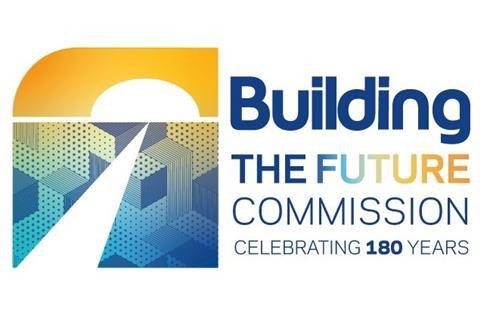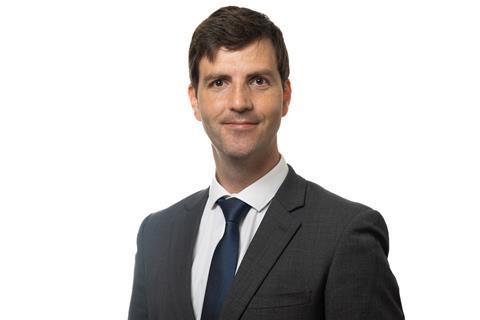The Building the Future Commission has named six up-and-coming professionals as winners of its Future Thinkers Awards. Here, the victorious candidates explain their thinking

The Building the Future Commission invited up-and-coming construction professionals to propose ideas for transforming the industry, making the way we build smarter, more efficient and more sustainable. Their responses ranged from new ways of thinking about material passports to teaching construction as a subject at schools. Our judges have chosen six winners. These are their ideas:

Evie Martin, architectural assistant, BDP

Visualisations of schemes in planning applications or consultations are an important way of showing communities what a scheme would look like when built. However, the people represented in these graphics are often lifted with little thought from existing image libraries and are not an accurate representation of the communities where the scheme is located.
BDP architectural assistant Evie Martin has developed a library of illustrated characters which give a much greater range of characteristics than are normally found in visualisations. The BDP People Library contains more than 100 diverse characters which will eventually be open source, allowing anyone across the industry to use it.
All of the figures have the option to change skin, hair and clothing colour to appropriately represent the project in question. They include people with visible diabetes Libre patches, colostomy bags, type 4a hair as well as headphones that imply a need for sensory reduction. Martin intends this to be an ever-evolving project and says she enjoys receiving suggestions for new characters to design.
A guidance document aiming to prompt designers to consider how to populate their visualisations more thoughtfully has already been open sourced. It aims to bring awareness to the impact of small details within images that can help to portray a sense of appropriate diversity and inclusion.
We really need to put more thought into who we are representing in these images, making them more inclusive, more diverse
Martin, who works in BDP’s Sheffield office, says the idea came from a conversation she had with a director about an image of a hospital scheme where the figures were abstract silhouettes coloured white.
“We started picking it apart and realised that even that image which had no colour on it or even much detail started to tell a story in terms of what was happening in that image,” she says.
“That was the trigger for thinking about the kind of power that all of these images have and thinking about how we really need to put more thought into who we are representing in these images, making them more inclusive, more diverse.”
The conversation made her realise that she was also guilty of throwing characters into visualisations under tight time constraints, focusing more on the angles and positions of the characters than the traits they had.
She says unconscious bias “100%” plays a part in visualisations. “We’re all limited to our own experiences and I don’t think it’s uncommon to naturally fall into that trap of representing what’s familiar to us, as well as just having that library of handy people who might be at the correct angle.
“I wanted to create a kind of guideline for myself initially – and then it became for others – setting guidelines for how to pick that process apart, how you can think about that more strategically and more fairly to make sure that we’re really challenging who we are representing in these images and challenging what stories we want to tell.”
Martin continues: “Thinking about even stereotypical representations of parents, for example, you often just see a woman with a pram, maybe on her own, as opposed to a male couple who have their own child.”
The library and its accompanying guidance have already been deployed for a regeneration project at Castlefield viaduct in Manchester, and it was used as a tool for the women of the world foundation, an organisation that was looking to challenge and improve the representation of women in the construction industry.
Judges’ verdict: What an effective idea and one that challenges us all – love the fact that Evie has worked with Epic games on this – using expert, cutting-edge and relevant technology, the whole library and the fact that it is available to all should allow universal adoption to the benefit of the sector and the PowerPoint presentation, and being walked through it by “Charlie” was compelling and powerful.
Shruti Ganesh, sustainability consultant, Sweco
Construction projects are awash with data, but how much of it is used or shared? The nature of the industry means important information which could make sustainable practices like material reuse easier to implement is often siloed in fragmented and incassable archives for individual projects.

Sweco sustainability consultant Shruti Ganesh proposes a cloud-based database which collects models from projects in planning applications which are updated as the schemes progress. The platform, called Urban Dataverse, would be hosted by a city authority and funded through a subscription model.
The models would become a repository for quantities of materials, building performance metrics and material properties. Consultants, developers, researchers and contractors could access the data through various levels of permissions for a broad range of uses.
We hope to create a city-platform where decisions are sustainable, equitable and data-driven
One use could be as a live dashboard of materials in a city that are available for reuse. When a building is being demolished, any materials which can be reused would be shown as available to others in the region, and the database – called “Circular Hub” – would try and match them to projects at design and construction stages.
Another application could be matching project teams to opportunities for carbon offsetting. A “Net Zero Hub” would connect projects to charities, independent groups and NGOs that match the team’s fiscal obligations with their company ethos, giving a city real-life examples of localised net zero ambitions.
“Through Urban Dataverse we hope to create a city-platform where decisions are sustainable, equitable and data-driven,” Ganesh says.
Judges’ verdict: This entry stood out. The presentation video demonstrated a good level of detail. It was good to see the net zero challenge tackled at a city scale
BE Change Makers, Built Environment - Smarter Transformation
What do councils do with all of their carbon offset funds?
BE Changemakers, a group of young construction professionals advocating systems change in the sector, want to see more money spent on community retrofit projects.
The group, which is part of the Glasgow-based Built Environment – Smarter Transformation organisation, are proposing a local retrofit ambassador scheme. This would allow small communities to come together to access funding from local authorities otherwise not accessible for single parties.
Ambassadors would communicate in plain language how locals who want to engage with retrofit works can upskill, allowing knowledge to propagate through a community. “We want to re-engage people with their buildings, better understanding the skills needed to enable a net zero future,” the group says.

Alongside this, they want to introduce a policy allowing volunteers to trade their time to access reduced costs. The “sweat equity” policy has been inspired by self-build schemes such as those pioneered by the architect Walter Segal and aims to stimulate a grassroots movement to upskill a green workforce.
“Communities deserve resilience, rather than redevelopment,” the group says. “In proposing a policy of Community Renaissance, the BE Changemakers want to drive local industry to provide the necessary infrastructure to upskill those people in the futureproofing of their own homes.”
We want to drive local industry to provide the necessary infrastructure to upskill those people in the futureproofing of their own homes
The group is mostly based in Scotland, with a few members in England. They meet every month – sometimes in person, sometimes virtually but mostly a mix of the two. They also hold events two or three times a month, with all of their work being voluntary.
Anna Stoll, the group’s spokesperson, says their idea came about after thinking about how a future which is regenerative would look in terms of communities. “We kept coming back to this idea of what does ‘community’ actually mean and how do we actually look to communities to be the heart of that just transition for the built environment,” she says.
“A lot of that conversation came down to accountability. It’s great when you can have a profitable and economically rewarding system for contractors, but what about communities and the everyday lives of people? How does that all work in circular together?”

Judges’ verdict: A really well thought-out considered idea that taps into the future generation of delivering up essential services: local, collaborative, networked with a big dose of personal responsibility.
The collective idea is compelling and coupled with a secure source of funding to underpin the long-term nature of the retrofit programme – could be delivered at scale.
Traditionally such sweat equity projects have been small scale, hard to get off the ground and legally complex, often depending on the good will of the local authority. Undertaking a collaborative and collective approach to the NZ retro-fit challenge could create the replicability required for an effective solution. You can imagine neighbours trading time depending on their own skills in life.
Richard Wilson, cost manager, Turner & Townsend Alinea
Of all the issues currently afflicting construction, the skills shortage will arguably have the biggest impact on firms. Although apprenticeships have been a vital lifeline for the industry, the Construction Skills Network says an extra 225,000 construction workers may be needed by 2027.
Turner & Townsend Alinea cost manager Richard Wilson has proposed a long-term solution for his Future Thinkers entry. While a job in construction can draw from almost every subject taught at schools, from maths for quantity surveyors to art and design for architecture, no subject brings all these skills together in the context of the built environment. Wilson proposes introducing a new subject – construction and the built environment – into the curriculum in its own right.

His idea would see elements from a broad range of subjects taught to pupils to give them an overview of different roles in the industry, what they entail and what skills are needed. He says this would help to counter assumptions that construction is not an aspirational career choice.
If you asked me when I was 16 what jobs there are, I would have said joiners, electricians, bricklayers. All the other roles wouldn’t even have occurred to me
Wilson says a dedicated subject in the curriculum would teach the next generation of construction professionals the personal and business skills required to work in the industry, and provide an opportunity to learn about past health and safety failings in the sector.
He is a career changer himself, having worked as a police officer for 10 years before starting a new job in the built environment. “I wish I had done it 10 years ago but I had never considered all of these different roles,” Wilson says. “You just don’t appreciate all the built environment has to offer.”
“If the industry wants to improve, wants to become greener, more inclusive, productive, I think we need the right people. [The industry] just doesn’t capture young peoples’ attention.”
While he says apprenticeships do a good job in getting 16 and 17-year-olds into the sector, this is often too late for many younger people who have already decided that construction is not for them.
“The built environment doesn’t sell itself very well. If you asked me when I was 16 what jobs there are, I would have said joiners, electricians, bricklayers. All the other roles wouldn’t even have occurred to me.”
Judges’ verdict: This was a really good presentation and the wide variety of taught subjects and their application to the built environment showed significant thought. Educating at school age may well encourage students into the industry if only by informing them of the available roles so they know they exist.
Ciara Durkin, senior whole life carbon advisor, Laing O’Rourke
Material passports have a leading role to play in construction’s march towards net zero. But the process of logging all products in a building can be time-consuming, inefficient and prone to errors.
Materials arriving on site in delivery vans are manually logged by presenting paper invoices to site security, a system which is both slow and risks data being entered inaccurately.
Ciara Durkin’s proposal is to have these invoices electronically read by an app. A senior whole life carbon adviser at Laing O’Rourke, Durkin says this approach would increase efficiency, practicality and accuracy when assembling material passports.

Paper invoices would be scanned using smartphones and text converted into machine-readable data by character recognition software. Algorithms would then extract relevant data, harmonise it into standardised formats and assign a unique reference to each material in the database.
A digital final bill of quantities in a project would be represented by a single QR code physically printed onto a building to allow access to the database. When scanned, it would provide detailed and accurate information to enable decision making that contributes to the circular economy and sustainable reuse of materials.
Durkin worked in sustainability and architecture before moving to Laing O’Rourke, and found that problems which arise during construction become “multiples of multiples”.
We’ve been seeing is that a BIM model doesn’t really capture probably even 20% of what actually occurs on site
She says: “With large contracts, when they go over £100m, because it’s such a disconnected workstream, and there’s so many players in the market, it means that problems just escalate really quickly.”
Solving these problems is about creating simplicity, Durkin says. It requires a model which everyone can understand and use, and which holds people accountable for the amount of materials they buy for a site.
While material passports have been talked about for years, they were originally intended to be used through BIM models, an approach which Durkin says has shortcomings.
“The biggest thing that we have been seeing is that a BIM model doesn’t really capture probably even 20% of what actually occurs on site, so the best way to understand that is to come up with something that everyone can use, not just specialist digital engineers.”
Durkin’s work at Laing O’Rourke has included writing the standard for the firm’s carbon measurement process. For her work on her material passports idea, she has compared paper invoices of materials arriving on site with BIM models to uncover discrepancies.
“Follow the money, follow the carbon, was our idea. If it has been paid for on the site, it is somewhere – but a model won’t take that into account.”
Judges’ verdict: This was a very well-presented entry. Concise and well-made points and it was valuable to see the material passport challenges and solutions from the point of view of the contractor working on site
Alisha Lad, content consultant, Liz Male Consulting
There is no major sector in the UK where issues with diversity are more stark than in construction. Just one in eight construction workers are female, and the industry has the largest gender pay gap of any sector – 23.7% in 2021/22.

A mere 6% of construction workers are from black, Asian or ethnic minority backgrounds. An alarming 76% of black and 77% of Asian employees in construction have reported facing limited career progression due to their race or other protected characteristics.
Alisha Lad, content consultant at construction industry PR firm Liz Male Consulting, has proposed using TikTok to improve representation of diverse groups in construction. She works with social media at the firm and would like to see more construction companies joining platforms such as TikTok to show that the industry is actively looking to improve equality, diversity and inclusion.
A quarter of 14 to 18-year-olds don’t see people who look like them on TV, so they start to turn to apps like Youtube and TikTok
“I am a woman of colour, I am British Asian, so diversity is close to my heart. I have always been interested in it so, when I started researching construction and how low the numbers of BAME workers were – and how low it is in PR itself – I just thought I would start creating something.”
She says she is a “big advocate” for TikTok, and while lots of firms in the industry are on the platform, a lot of the content is focused on the trades rather than company ethics or diversity initiatives.
“A quarter of 14 to 18-year-olds don’t see people who look like them on TV, so they start to turn to apps like YouTube and TikTok so they can find people they can relate to and that reflect themselves,” Lad says.
“I think it would also help [solve] the skills shortage because younger generations would see people like them working in construction, and they might want to join.”
Uses of the app could include a series of monthly webinars hosted by people that work in the sector to discuss issues around equality and inclusion and what steps can be taken to make improvements. Another use could be creating dedicated accounts which promote diverse voices in the industry.
“The industry must break free from the all-white, all-male reputation that it holds and embrace social media platforms to remove this shadow over its future,” Lad says.
Judges’ verdict: Raising the profile of BAME in construction is a really important issue. This shows insight into getting messages to a demographic that industry fails to reach.
Other Future Thinkers proposals
Rosy Watts, associate director, Turner & Townsend and Alinea
Watts wants to “put the S in ESG” with greater use of local SMEs in supply chains to provide the communities where a scheme is being built with jobs, and embedding this in procurement processes. She says this would foster a closer connection between the project and locals, helping with planning approvals. It could also make it easier to reuse materials as local firms would have a better knowledge of where they could be used.
Lia Minty, engineer, Max Fordham
The shift towards working from home during the pandemic has seen office buildings in city centres under-occupied. Minty suggests refurbishing this excess space into places which better meet the demands of the future. This could include mixed-use housing and co-working space buildings that function as systems, using heat generated by workers during the day to heat apartments in the evening.
Rupert Parker, founder and chief executive, Building Passport
Parker wants to develop material passports to encompass all data for a building, not just its materials but all technical, legal and financial information. This would cover the lifetime of the building from its design and construction through to occupancy and demolition. He says this would help real estate investors by better reflecting building quality and condition, enabling faster and safer transactions.
Elizabeth Magee, development manager, Urban & Civic
The average age of councillors in 2022 was 60, and 42% were over 65. For council planning committees to better represent the communities they serve, Watts says their members should be randomly selected from the electoral register. She proposes that people would be chosen in the same way as juries using council-held data, and it would be a civic duty.
Hugh Franklin, head, AeroBarrierUK
Franklin proposes an app on phones which could answer builders’ questions about how to make schemes sustainable. This would offer a range of potential solutions based on visual information or drawings, encouraging site-specific thinking dependent on local conditions rather than pigeonholing specific solutions.
Adam Dodd, framework management trainee, Willmott Dixon
Dodd wants to see greater use of two-stage tendering as a route to ensure greater collaboration on projects. Although the process takes longer, he says this would enable everyone to get around the table as early as possible, reducing risk, encouraging innovation and enhancing project quality.
Thomas Griffiths, graduate construction manager, Laing O’Rourke
Griffiths’ proposal is for teams to share standardised design elements of schemes so they can be taken off a shelf instead of worked up from scratch. He gives the example of a corridor with built-in MEP systems which, once it has been established as a suitable design, could be used again by different teams in any future project.
Wojciech Szewczak, associate, strategic sustainability consulting, Ramboll
Szewczak proposes building regenerative infrastructure which can restore any damage caused during its constructino by aiding a natural recovery of the environment and its natural systems. It would be built or renewed in a net-positive way using existing resources and creating practices, cultures and procesdures with positive environmental and social impact.
Wing Tsang, specialist content creator, Liz Male Consulting
The UK has a total prison population of nearly 90,000 people, a potentially valuable pool of people to help address the industry’s skills shortage. Tsang would like to see more firms attracting prisoners into the industry by offering them training opportunities, jobs and apprenticeships while they are serving their sentences or after release.
Hannah Carpenter, senior account director, Liz Male Consulting
Carpenter would like to see the creation of an education programme for the entire construction indusntry, including students, to inform people about the Building Safety Act. This would include mandatory CPD for members of construction professional bodies, online resources for others, and changes to curriculum requirements for further education colleges and universities.
Colin Omorodion
Omorodion wants communities to have more involvement in shaping local development projects. He proposes setting aside 5 - 10% of the total funding for urban regeneration projects to be set side for co-investing by communities, giving responsibiltiy for goveranance and risk management to local authorities and letting communities elect a representative to sit on project board meetings throughout the development cycle.
Sam Reeson, principal planner, ACE Emerging Professionals
Reeson proposes increasing diversity in the industry by directing professionals to EDI training at their companies, establishing EDI committees to support equality, diversity and inclusion at the workplace, creating new diverse recruitment guidelines, promoting fresh perspectives on people’s diverse backgrounds and motivating colleagues to showcase their culture and traditions in the workplace to make them feel included.
Gaurav Kataria, building performance and sustainability engineer, Harley Haddow
Instead of separating embodied and operational carbon, Kataria would like to see more of the industry standardising whole life carbon benchmarks. Kataria says this would put a spotlight on holistic design approaches and push stakeholders to seek newer alternative pathways that haven’t been explored previously.



























No comments yet